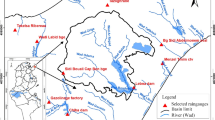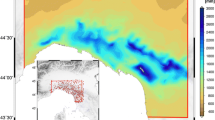Abstract
An intensification of extreme rainfall events have characterized several areas of peninsular and insular Italy since the early 2000s, suggesting an upward ongoing trend likely driven by climate change. In the present study temporal changes in 1-, 3-, 6-, 12- and 24-h annual maxima rainfall series from more than 200 sites in Sicily region (Italy) are examined. A regional study is performed in order to reduce the uncertainty in change detection related to the limited length of the available records of extreme rainfall series. More specifically, annual maxima series are treated according to a regional flood index - type approach to frequency analysis, by assuming stationarity on a decadal time scale. First a cluster analysis using at-site characteristics is used to determine homogeneous rainfall regions. Then, potential changes in regional L-moment ratios are analyzed using a 10-year moving window. Furthermore, the shapes of regional growth curves, derived by splitting the records into separate decades, are compared. In addition, a jackknife procedure is used to assess uncertainty in the fitted growth curves and to identify significant trends in quantile estimates. Results reveal that L-moment ratios show a general decreasing trend and that growth curves for the last decade (2000–2009) usually do not stand above the others, with the only exception of the ones related to the outer western part of Sicily. On the other hand, rainfall quantile estimates for the same period are the highest values almost all over the region. An explanation can be found in the increase of subregional average medians, largely caused by recent severe local storms.








Similar content being viewed by others
References
Adamowski K, Bougadis J (2003) Detection of trends in annual extreme rainfall. Hydrol Process 17:3547–3560
ANCE-CRESME (2012) Lo stato del territorio italiano 2012. Insediamento e rischio sismico e idrogeologico (in italian)
Anderson TW, Darling DA (1952) Asymptotic theory of certain goodness-of-fit criteria based on stochastic processes. Ann Math Stat 23:193–212
Arnone E, Pumo D, Viola F, Noto LV, La Loggia G (2013) Rainfall statistics changes in Sicily. Hydrol Earth Syst Sci 17(7):2449–2458
Bodini A, Cossu Q (2010) Vulnerability assessment of Centra-East Sardinia to extreme rainfall events. Nat Hazards Earth Syst Sci 10(1):61–72
Bonaccorso B, Cancelliere A, Rossi G (2005) Detecting trends and extreme rainfall series in Sicily. Adv Geosci 2:7–11
Brunetti M, Maugeri M, Nanni T (2001) Changes in total precipitation, rainy days and extreme events in Northeastern Italy. Int J Climatol 21:861–871
Brunetti M, Buffoni L, Mangianti F, Maugeri M, Nanni T (2004) Temperature, precipitation and extreme events during the last century in Italy. Glob Planet Chang 40(1–2):141–149
Caloiero T, Coscarelli R, Ferrari E, Mancini M (2011) Precipitation change in Southern Italy linked to global scale oscillation indexes. Nat Hazards Earth Syst Sci 11(6):1683–1694
Cislaghi M, De Michele C, Ghezzi A, Rosso R (2005) Statistical assessment of trends and oscillations in rainfall dynamics: analysis of long daily Italian series. Atmos Res 77:188–202
Cooley D, Naveau P, Poncet P (2006) Variograms for spatial max-stable random fields. In: Bertail P, Doukhan P, Soulier P (eds) Dependence in Probability and Statistics, vol 187. Springer, New York, pp. 373–390
Dalrymple, T. (1960) Flood Frequency Analysis. Technical Report Water Supply Papers, 1543-A, U.S. Geol. Surv
Diodato N, Bellocchi G (2010) Storminess and Environmental Changes in the Mediterranean Central Area. Earth Interact 4:1–16
Fowler HJ, Kilsby CG (2003) A regional frequency analysis of United Kingdom extreme rainfall from 1961 to 2000. Int J Climatol 23:1313–1334
Gabriele S, Chiaravalloti F (2013) Using the meteorological information for the regional rainfall frequency analysis: an application to Sicily. Water Resour Manag 27:1721–1735
Goodess C, Jones PD (2002) Links between circulation and changes in the characteristics of Iberian rainfall. Int J Climatol 22:1593–1615
Hampel FR (1974) The influence curve and its role in robust estimation. J Am Stat Assoc 69:383–393
Hosking JRM, Wallis JR (1997) Regional frequency analysis: an approach based on L-moments. Cambridge University Press, Cambridge
IPCC, (2014) Climate change 2014: Impacts, adaptation, and vulnerability, Part B: Regional aspects. Contribution of Working Group II to the Fifth Assessment Report of the Intergovernmental Panel on Climate Change, Cambridge University Press, Cambridge, pp. 688
Jongman B, Hochrainer-Stigler S, Feyen L, Aerts JCJH, Mechler R, Botzen WJW, Bouwer LM, Pflug G, Rojas R, Ward PJ (2014) Increasing stress on disaster-risk finance due to large floods. Nat Clim Chang 4(4):264–268
Jung I, Baea D, Kimb G (2011) Recent trends of mean and extreme precipitation in Korea. Int J Climatol 31:359–370
Kaufman L, Rousseuw PJ (1990) Finding groups in data: an introduction to cluster analysis. Wiley, New York
Kendall, M.G. (1975). Rank correlation methods, 4th edn. Charles Griffin, London.
Malekinezhad H, Zare-Garizi A (2014) Regional frequency analysis of daily rainfall extremes using L-moments approach. Atmosfera 27(4):411–427
Mann HB (1945) Non parametric test against trend. Econometrica 13:245–259
Marani M, Zanetti S (2015) Long-term oscillations in rainfall extremes in a 268 year daily time series. Water Resour Res 51(1):639–647
Miller RG (1974) The Jackknife – a review. Biometrika 61(1):1–15
Moran PAP (1950) Notes on continuous stochastic phenomena. Biometrika 37:17–23
Muñoz-Diaz D, Rodrigo FS (2004) Spatio-temporal patterns of seasonal rainfall in Spain (1912–2000) using cluster and principal component analysis: comparison. Ann Geophys 22(5):1435–1448
Ngongondo CS, Xu C-Y, Tallaksen LM, Alemaw B, Chirwa T (2011) Regional frequency analysis of rainfall extremes in southern Malawi using the index rainfall and L-moments approaches. Stoch Env Res Risk A 25:939–955
Noto LV, La Loggia G (2009) Use of L-moments approach for regional flood frequency analysis in Sicily, Italy. Water Resour Manag 23(11):2207–2229
Ribatet M (2013) Spatial extremes: max-stable processes at work. Journal de la Société Française de Statistique 154(2):156–177
Robinson A, Reed D (1999) Flood estimation hand book: statistical procedure for flood frequency estimation, vol 3. Institute of Hydrology, Wallingford
Schlather M, Tawn J (2003) A dependence measure for multivariate and spatial extremes: properties and inference. Biometrika 90(1):139–156
Sciuto G, Bonaccorso B, Cancelliere A, Rossi G (2009) Quality control of daily rainfall data with neural networks. J Hydrol 364:13–22
Viglione A, Laio F, Claps P (2007) A comparison of homogeneity tests for regional frequency analysis. Water Resour Res 43:W03428. doi:10.1029/2006WR005095.
Ward JH (1963) Hierarchical grouping to optimise an objective function. J Am Stat Assoc 58:236–244
Wilks DS (1995) Statistical methods in the atmosphere sciences. Academic Press, California
Yang T, Xu C-Y, Shao Q-X, Chen X (2010a) Regional flood frequency and spatial patterns analysis in the Pearl River Delta region using L-moments approach. Stoch Env Res Risk A 24:165–182
Yang T, Shao QX, Hao Z-C, Chen X, Zhang Z, Xu C-Y, Sun L (2010b) Regional frequency analysis and spatiotemporal pattern characterization of rainfall extremes in Pearl River Basin, Southern China. J Hydrol 380(3–4):386–405
Acknowledgments
This study is part of the research activities carried out within the research contract n. F68C13000060008 between Sicilia e-Ricerca SpA and the University of Messina (European Regional Development Fund – PO FESR Sicilia 2007-2013, Linea di intervento 2.3.1. C).
Author information
Authors and Affiliations
Corresponding author
Rights and permissions
About this article
Cite this article
Bonaccorso, B., Aronica, G.T. Estimating Temporal Changes in Extreme Rainfall in Sicily Region (Italy). Water Resour Manage 30, 5651–5670 (2016). https://doi.org/10.1007/s11269-016-1442-3
Received:
Accepted:
Published:
Issue Date:
DOI: https://doi.org/10.1007/s11269-016-1442-3




